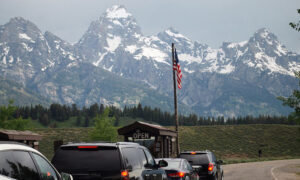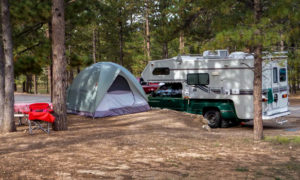
Last updated on April 27th, 2009 at 07:00 pm

Some of the most beautiful places an RVer can visit don’t have a campground. Even in places where there is a campground the sites may not have hookups. That’s okay because almost all RVs are made for dry-camping.
The easiest way to practice dry camping is at a campground with hookups, only don’t hook up. Instead try to dry-camp as long as you can following the tips below.
Then, if you run out of fresh water and your holding tanks fill up, you won’t have to drive to a dump station. If your batteries need charging you can just plug in.
Once your batteries are charged, you’ve refilled the fresh water tank and emptied the black and gray tanks, unhook again and try to prolong the time. If you can dry-camp for at least a few days you’re ready to give real boondocking a try.
Here are some tips to make dry-camping easier and help extend your stay.
Water Use:
- Your black and gray tanks should be empty and your fresh water tank should be full when you reach camp.
- Take along one or more portable containers of fresh water.
- Being careful with your water use is the only way keep from needing to dump waste water tanks too soon.
- When boondocking, the gray water tank usually fills before the black tank does. You can extend your stay a little longer by disposing of gray water (such as dish water) in the toilet.
- While waiting for the shower or sink water to get hot, save the cold water in a plastic dishpan or bucket for reuse… rinsing dishes, washing hands etc.
- When your holding tanks are full, you can dump them into a portable “blue” toter and take it to a nearby dump station. To make the best use of your time at the dump station, be sure to fill up your freshwater containers while you are there. Be sure the water is potable.
Electrical Tips
- Turn off lights, TVs and radios when not in use. Don’t use more lights than necessary.
- Make the most use of daylight… getting up early and going to bed soon after dark minimizes the use of lights.
- Use rechargeable battery-operated reading lights for reading in bed, and for flashlights and lanterns outside. Keep a supply of extra batteries on hand.
- Monitor your house batteries with a digital voltmeter. (12.6+ volts = fully charged, 11.6 volts = discharged) Recharge your batteries at or before reaching 80 percent discharged, or 11.8 volts, to prolong their life.
- 120v AC appliances operating on an inverter pull a lot of power from your batteries so use them conservatively.
- Adding more house batteries will increase your storage capacity of electricity and extend your ability to boondock longer.
- Solar panels installed on top of your RV will help to charge house batteries to extend your boondocking time.
Read the following Articles at RVbasics.com
RV Boondocking – the Basics
RV Boondocking Across America
RV Travel and Boondocking in US Southwest
RVing on a Budget
FREE RV Camping on Bureau Of Land Management Land
10 Tips To Cut Your RV Travel Expenses
FREE RV Camping at Casinos – RV Basics .com
RV Camping At Corps of Engineers Lakes
———–
Check out these Frugal Shunpiker’s Guides
RV Boondocking In New Mexico
RV Boondocking In Southern Texas
RV Boondocking In Arizona
Click Here!
—-







To avoid wasting water while running the hot water tap in the bathroom while waiting for it to get hot to wash your hands, I re-plumbed the toilet to flush with hot water. That way you flush with cooled off hot water and the wash basin will have hot water at the faucet almost immediately afterwords. To save electricity you should change out all your light bulbs to the new LED ones. You can run them almost any time you want and your battery hardly notices a thing. Jeff Cardinal
To clean the sensors on a blackwater holding tank, you can buy a $10 bottle of sensor cleaner, but a cheaper way is to put some automatic dishwasher soap into it. That stuff is very strong and it made my level sensors work just as well as the expensive stuff you buy at an RV store.
That’s one of those ‘why didn’t I think of that’ ideas, Jeff. In all my years of RVing, this is the first time I’ve heard this idea. Thank’s for sharing it.
About how much dishwasher detergent should we use, Jeff? Have a favorite brand?